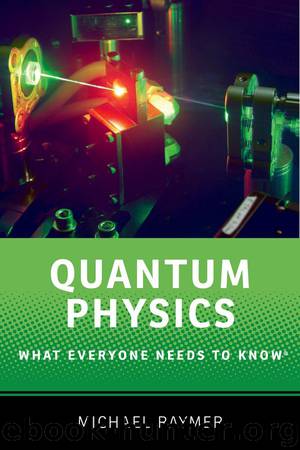Quantum Physics by Michael G. Raymer

Author:Michael G. Raymer
Language: eng
Format: epub
Publisher: Oxford University Press
Published: 2017-03-13T04:00:00+00:00
What prevents communication between the two sides of the experiment?
In previous discussions, I implied it was legitimate to assume there was no communication between the two dancers and the persons or mechanisms operating the strobes. But how can we be certain of that? Scientists need to be on the lookout for physical mechanisms that might be at work, even if the mechanisms might operate by physical processes as yet unknown. (For example, a scientist of the sixteenth century would be mightily surprised to learn that two people could communicate nearly instantaneously across a distance of, say, a thousand miles. Now we just whip out our mobile phones.) There is a way we can set up our Bell-test experiment and be reasonably certain there was no communication: by appealing to the principle of ‘causality’ as it is now understood in the context of Einstein’s theory of relativity—a theory that is on very firm footing.
The basic notion of causality is simple enough. Some physical influence causes some physical effect. For example, when lighting strikes, it makes the sound of thunder. Sound, which is a disturbance of ambient air pressure, travels at a speed of 344 meters per second. So a person 344 meters from the lighting strike hears thunder one second after the strike, whereas a person 688 meters from the lighting strike hears thunder two seconds after the strike. You can think of an imaginary ‘sphere of influence’ expanding at the speed of sound from the location of the lightning strike. At any particular time, only those people and objects within the sphere of influence can be affected by the sound caused by the strike. An event such as a lightning strike is a ‘cause,’ in that it may cause other events (such as your eardrums vibrating) at distant locations sometime in the future.
Einstein’s great insight was that, in Nature, there exists a fastest possible kind of disturbance that can carry causes from one place to another, and this fastest possible disturbance is light. The speed of light equals about 3 × 108 meters per second. This is the absolute ‘speed limit’ for all entities and influences in the universe, as far as we know. For example, the light generated at the strike point travels to your eyes at the speed of light, and no disturbance can possibly travel any faster. Therefore, in the split second after the strike and before the light reaches your eyes, from your perspective it is truly as if the strike never occurred. As the light travels from the strike point, a ‘causal sphere of influence’ expands at the speed of light from this point. At any particular time, only those people within this expanding sphere can know about the strike; those outside the sphere cannot (yet) be affected in any way by the existence of the strike. That is, the strike cannot be a cause of any event that may occur outside the expanding causal sphere of influence. We can state a principle of relativity
Download
This site does not store any files on its server. We only index and link to content provided by other sites. Please contact the content providers to delete copyright contents if any and email us, we'll remove relevant links or contents immediately.
The Complete Stick Figure Physics Tutorials by Allen Sarah(7135)
Secrets of Antigravity Propulsion: Tesla, UFOs, and Classified Aerospace Technology by Ph.D. Paul A. Laviolette(4974)
Thing Explainer by Randall Munroe(3782)
The River of Consciousness by Oliver Sacks(3412)
The Order of Time by Carlo Rovelli(3072)
How To by Randall Munroe(2911)
I Live in the Future & Here's How It Works by Nick Bilton(2839)
A Brief History of Time by Stephen Hawking(2819)
What If?: Serious Scientific Answers to Absurd Hypothetical Questions by Randall Munroe(2542)
The Great Unknown by Marcus du Sautoy(2532)
Midnight in Chernobyl by Adam Higginbotham(2384)
Blockchain: Ultimate Step By Step Guide To Understanding Blockchain Technology, Bitcoin Creation, and the future of Money (Novice to Expert) by Keizer Söze(2379)
Networks: An Introduction by Newman Mark(2264)
The Meaning of it All by Richard Feynman(2213)
Easy Electronics by Charles Platt(2204)
The Tao of Physics by Fritjof Capra(2162)
Midnight in Chernobyl: The Untold Story of the World's Greatest Nuclear Disaster by Adam Higginbotham(2074)
When by Daniel H Pink(2020)
Introducing Relativity by Bruce Bassett(2015)
